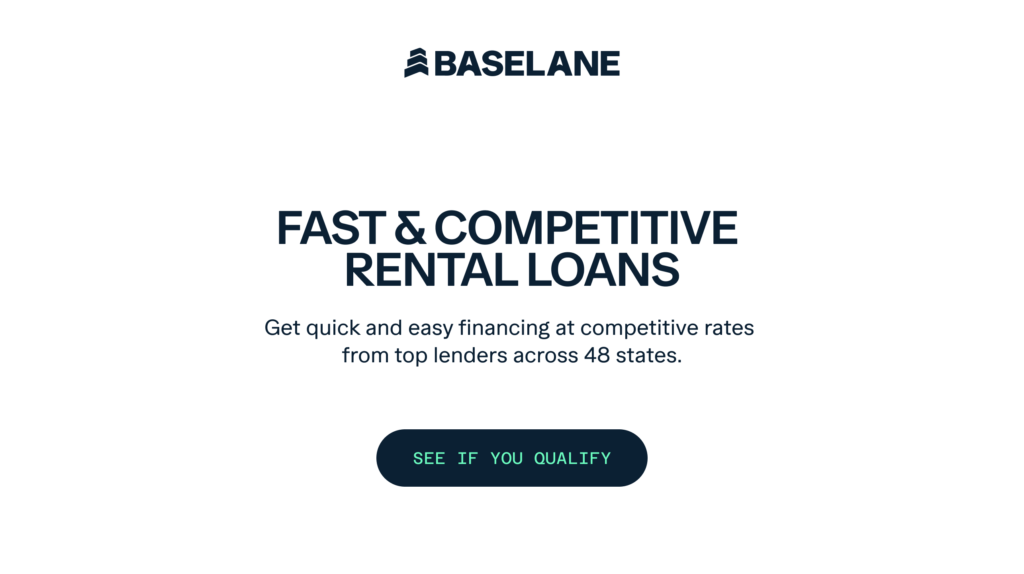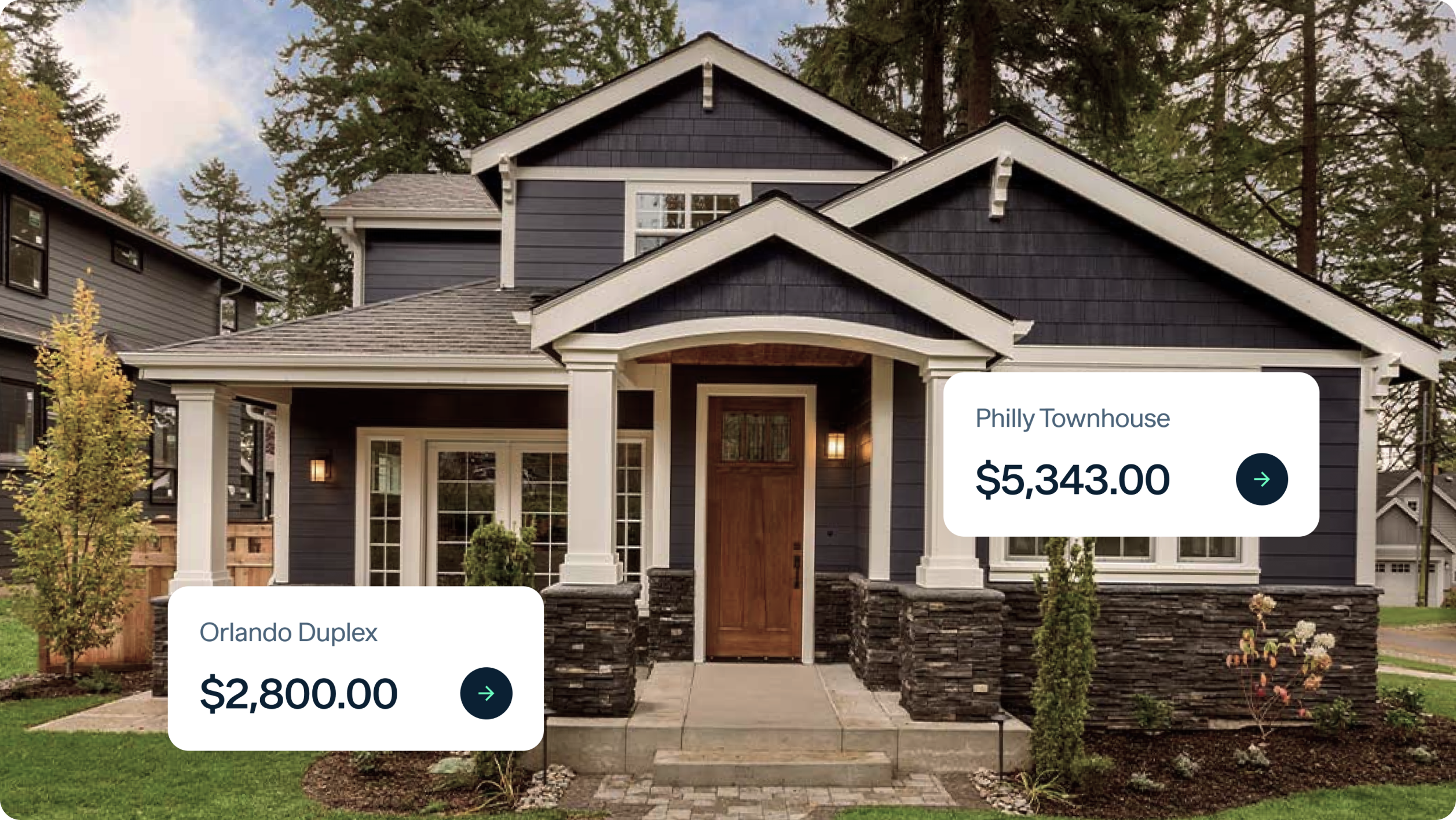There’s no one right way to finance a vacation home, and your success in the short-term rental market hinges on choosing the best option for your goals and finances.
This guide covers everything you need to know about short-term rental financing options, what lenders look for, and a step-by-step overview of the process for how to finance Airbnb and short-term rentals.
Key takeaways:
- Airbnb financing options include conventional mortgages, investment property loans, DSCR loans, HELOCs, and other alternatives like bridge and hard money loans.
- Short-term rental financing offers flexibility for income-based approval and leveraging existing equity but involves higher interest rates and strict qualifications.
- Mortgage rates aren’t expected to drop significantly in 2025 but slower home price growth projections could create opportunities for financing Airbnb properties.
- Vacation home financing generally requires a 20%-30% down payment, a credit score of 620+, a DTI ratio under 43%, and 2-6 months of cash reserves.
- Lenders often ask for documents of existing assets, recent pay stubs and tax returns, bank statements, and rental income projections.
What is short-term rental financing?
Short-term rental financing (STR financing) refers to the various methods of obtaining funds to purchase or refinance a property intended for use as a short-term rental, like Airbnb and vacation homes. Unlike long-term rentals, properties rented for short stays often have less predictable income and different regulations. As a result, lenders typically have different criteria and terms for financing short-term rental properties compared to long-term rentals or primary residences.
Choosing between short-term vs. long-term rental depends on your market goals, cash flow needs, and property location.
Short-term rental financing: Current market trends (2025)
With interest rates stabilizing, home prices showing moderate growth, and demand for STRs climbing, 2025 is shaping up as a pivotal year for real estate investors.
Let’s break it down:
- Interest rates: In January, the Fed decided to maintain interest rates at 4.25%-4.50%, with the possibility of two rate cuts by year-end. What this means for mortgage rates is still unclear, as the Fed’s rate is just one of many factors affecting mortgage prices.
- Mortgage rates: As of February 2025, 30-year fixed mortgage rates are at 6.76%, down from a 7.04% peak in January and 6.90% the previous year. Mortgage rates are expected to average 6.4% in 2025, slightly higher than predicted, which could impact investments. Check out our guide on today’s investing property mortgage rates.
- Home prices: U.S. home prices are forecasted to rise 1.1% this year, a recent downward revision from the Zillow Home Value Index 12-month prediction of 2.9%. Slower home price growth can reduce competition and lead to more realistic property valuations, giving investors better negotiating power and reducing the risk of overpaying.
Pros of short-term rental financing
- Cash-flow-based lending: Lenders evaluate the property’s income potential instead of relying solely on personal finances. DSCR loans focus on projected rental income, making them ideal for investors with non-traditional income sources.
- Flexible loan options: Short-term rental financing offers flexibility for income-based approval and using equity to purchase new investments through cash-out refinancing.
- Higher ROI potential: Short-term rentals often generate more income than long-term leases. For example, renting a property on Airbnb for $200 per night at 70% occupancy can earn $51,000 annually, compared to $30,000 from a long-term lease at $2,500 per month.
Cons of short-term rental financing
- Higher interest rates: STR loans typically have higher interest rates (0.5%-1% more than traditional mortgages) because they’re classified as investment loans, which lenders see as higher risk.
- Stricter qualification requirements: Vacation rental financing often requires higher credit scores (680+), larger down payments (20%–30%), and proof of strong rental income potential. Lenders may also demand a debt-to-income (DTI) ratio below 43% or a debt service coverage ratio (DSCR) of at least 1.25.
- Market volatility: STR demand can fluctuate due to seasonality, competition, or climate changes. While highly seasonal markets may offer opportunities for peak-season rates, markets with low seasonality may provide more predictable year-round income. Diversifying your portfolio can help mitigate risk.
Short-term rental and Airbnb financing options
| Financing Option | Best for | Eligibility | Term | Down Payment | Pros | Cons |
|---|---|---|---|---|---|---|
| Conventional Mortgage | Primary residences, occasional rental use | Credit score 620+, DTI < 43% | 15-30 years | 3%-5% | Lower interest rates | High credit requirements |
| DSCR Loan | STRs with strong rental income | DSCR ≥ 1.25, credit score 680+ | 15-30 years | 20%-30% | Income-based approval | Higher interest rates |
| HELOC | Leveraging equity in existing property | Equity in property, credit score 700+ | 5-10 years | Varies with equity | Flexible funding | Variable interest rates |
| Investment Loan | Properties exclusively used as STRs | Credit score 680+, proof of income | 15-30 years | 15%-25% | No occupancy requirement | Higher down payments |
| SBA Loan | Business-owned short-term rentals | Business registration, credit score 680+ | Up to 25 years | 10%-20% | Lower down payment | Extensive paperwork |
| VA Loan | Multi-unit, owner-occupied primary residence | Veteran status, owner-occupancy | 15-30 years | 0% | Owner-occupancy required | No down payment |
| FHA Loan | Multi-unit, owner-occupied STRs | Credit score 620+, owner-occupied | 15-30 years | 3.5%-10% | Low down payment | One year owner-occupancy requirement |
| Cash-Out Refinancing | Accessing equity in existing properties | Property equity, credit score 680+ | 15-30 years | Varies with equity | Access to cash | Increased debt load |
| Hard Money Loan | Quick STR purchases or rehabs | Clear repayment plan, property as collateral | 6 months to 2 years | 10%-30% | Fast approval | High rates, short term |
| Bridge Loan | Temporary financing needs | Proof of repayment capacity, 20% equity | 6 months to 1 year | 20%-25% | Quick access to funds | Limited borrower protections |
| Portfolio Loan | Financing multiple STR properties | Rental portfolio, credit score 620+ | 10-30 years | 20%-30% | Consolidates multiple mortgages | Higher interest rates |
Common short-term rental and Airbnb financing options:
- Conventional mortgage: For owner-occupied primary residences with occasional short-term rental use.
- Investment property loan: For properties exclusively used as short-term rentals.
- Debt-service coverage ratio (DSCR) loan: Qualification based on the property’s projected income rather than your personal income.
- Small Business Administration (SBA) Loan: SBA 504 loans can be used to finance owner-occupied short-term rental properties that operate as a business.
- Federal Housing Administration (FHA) Loan: Designed for properties owner-occupied for at least one year, but can be used to purchase multi-unit properties where owners live in one unit and rent out others.
- Veterans Affairs (VA) Loan: Intended for primary residences, but veterans can rent out other rooms or units.
- Home Equity Line of Credit (HELOC): Allows you to borrow against the equity of an existing property to finance a new purchase.
Other financing options for short-term rentals:
- Bridge loan: Short-term financing options used to bridge a financial gap within a property purchase transaction, useful in competitive markets.
- Portfolio loan: Combines multiple mortgages into one, offering more flexible terms and easier management for borrowers.
- Hard money loan: High-interest, short-term loans that experienced investors use to purchase and/or rehab properties, often funded by private investors.
- Cash-out refinancing: Leverages equity of an existing property to fund a new purchase, providing access to funds without taking out a new loan.
- Private financing: Includes loans from individuals or groups, offering flexible terms and faster approval compared to traditional lenders.
- House hacking: Involves buying a property as a primary residence, living in one part, and renting out the rest, reducing personal housing costs and simplifying owner-occupied financing.
How to finance Airbnb & short-term rentals
Financing Airbnb properties involves careful planning and strategy. Here’s a step-by-step guide:
Step 1: Define your goals
Before diving into financing options for your Airbnb or short-term rental (STR), set clear goals to guide your investment decisions.
Loan-specific rules for Airbnb properties
- Decide whether you’re buying, renovating, or refinancing a property.
- Determine if the property is for exclusive rental use or a mix of personal and rental purposes.
Estimate your budget:
- Down payment: Typically 20%-30% for STRs or as low as 3.5% for owner-occupied loans.
- Closing costs: Usually 3%-5% of the purchase price (e.g., taxes, lender fees, legal expenses).
- Mortgage payments: Currently around $2,205 per month, according to the Mortgage Bankers Association (MBA).
- Furnishings and upgrades: Consider upfront costs for furniture or property upgrades. For example, furnishing a 1-bedroom unit costs between $15,000-$25,000, with larger homes exceeding $50,000.
- Marketing and operating costs: Budget for listing fees (3%-8% per booking), cleaning ($50-$150 per turnover), utilities ($150-$300 per month), and other ongoing Airbnb expenses.
Here are the best bank accounts for Airbnb hosts to help keep track of all your expenses.
Analyze profitability:
- Occupancy rates and ADR: High-demand locations like Austin or Tampa often yield strong income potential.
- Seasonality: Assess how peak and off-seasons will impact cash flow.
- Potential earnings: Ensure rental income covers all expenses and delivers a positive return.
Tip: Use Baselane’s rental property ROI calculator to estimate potential returns and ensure you’re making a good investment.
Step 2: Assess your financial situation
Next, evaluate your financial health. This will determine your eligibility for various loan options and influence the terms you receive.
Review your assets and liabilities
- Assets: Include savings accounts, investments, and other liquid assets demonstrating financial stability.
- Liabilities: Account for existing debts like student loans, car payments, or credit card balances.
Tip: Reducing high-interest debts can improve your overall financial profile and debt-to-income ratio (DTI).
Check your credit score and history
- Credit Score: Aim for a score of 680+ for investment properties. A higher score can secure better loan terms.
- Action: Dispute inaccuracies on your credit report and ensure timely payments to improve your score.
Calculate your debt-to-income (DTI) ratio:
- Calculation: DTI = (Total Monthly Debt Payments / Gross Monthly Income) × 100
- Example: If your monthly debts total $2,000 and your gross income is $6,000, your DTI is 33%.
- Lender preference: Most lenders prefer a DTI below 43%.
Plan for the down payment
- Investment properties: Down payments typically range from 20%-30%.
- Owner-occupied properties: Down payments can start as low as 3.5% with FHA loans.
- Strategy: A larger down payment may lower your monthly payments and secure better loan terms.
Account for closing costs
- Typical costs: Range from 3%-5% of the home’s purchase price.
- Inclusions: Fees for appraisals, inspections, and loan origination.
Maintain cash reserves
- Purpose: Cash reserves ensure you can handle unexpected expenses like repairs or vacancies.
- Recommendation: Keep 3-6 months of mortgage payments and operating costs in reserve.
- Example: For a monthly mortgage of $2,500, aim for reserves of $7,500-$15,000.
Step 3: Compare financing options
Evaluate key factors that directly impact your costs, loan approval, and profitability. These include:
- Property type and location: Properties in high-demand markets (e.g., urban centers or coastal destinations) generally qualify for more financing options and competitive rates, but zoning restrictions and rent control laws could impact profitability. Single-family homes are easier to finance but usually generate less income than multi-family properties.
- Rental income potential: Higher rental income can help secure a larger loan, better terms, and reduce required reserves. Typically, lenders will consider 75% of the estimated rental income to account for potential vacancies and expenses. This projection is usually based on market rent data from an appraiser’s rental analysis or documented leases for similar properties in the area.
- Down payment requirements: Loan options with lower down payments can help conserve cash for renovations or future investments, but will often have higher interest rates. Larger downpayments require more upfront capital but have monthly payments, giving you more cash flow.
- Interest rates and fees: Current average 30-year fixed mortgage rates for investment properties hover around 6.85% as of February 2025. Even a 0.25% rate difference could save thousands over the loan term.
- Loan terms and repayment schedule: Shorter terms (15 years) have higher monthly payments but lower total interest. Longer terms (30 years) provide lower monthly payments but higher overall interest costs. For example, a 15-year loan for $400,000 at 6.75% would cost $3,528/month, while a 30-year loan at the same rate costs $2,595/month.
Step 4: Choose a lender
Now, once you’ve identified your goals and budget, the next step is finding a lender who understands short-term rental financing. Here’s how to choose a lender
- Reputation and experience: Look for lenders with a strong track record in STR financing and positive customer reviews.
- Loan options: Ensure they offer various loan types, such as conventional and asset-based loans.
- Interest rates and terms: Compare interest rates, loan terms, and repayment options to find the most favorable conditions.
- Customer service: Evaluate their customer support and willingness to guide the financing process.
- Flexibility: Check for flexible loan requirements and terms that align with your financial situation and investment goals.
Tip: Request pre-approval from multiple lenders to compare rates and terms side by side.
Step 5: Submit financial documents
Submit comprehensive and accurate financial documents when applying for financing for your short-term rental (STR) property.
Financial records
- Tax returns: Provide your personal tax returns for the past two years to demonstrate consistent income.
- Bank statements: Submit bank statements from the past six months to showcase your cash flow and savings.
- Assets and liabilities: Prepare statements detailing your current assets and liabilities to give lenders a clear picture of your financial standing.
- Business plan: Develop a comprehensive business plan outlining your strategy for the STR property, including market analysis and projected income.
Property information
- Comparative market analysis: Conduct a comparative market analysis (CMA) for your short-term rental property. Focus on key metrics such as Average Daily Rate (ADR), occupancy rates, and seasonal demand in your target area.
- Property condition report: Provide a detailed report on the property’s current condition, highlighting any necessary repairs or improvements.
- Insurance quotes: Obtain quotes for property insurance to account for this expense in your financial planning.
- Projected revenue analysis: Estimate potential earnings by calculating metrics like ADR and occupancy rate. For example, with an ADR of $215 and a 52% occupancy rate, your annual revenue would be $40,000.
Personal documentation
- Credit report: Ensure your credit report is accurate and meets the lender’s requirements, typically a minimum score of 620 for conventional loans.
- Employment verification: To confirm your income source, provide proof of employment, such as recent pay stubs or an employment verification letter.
- Existing rental portfolio performance (if applicable): If you own other rental properties, include performance metrics to demonstrate your experience and success in property management.
Step 6: Secure pre-approval
Securing pre-approval for financing your short-term rental (STR) property shows your borrowing capacity to sellers. Here’s an overview of the short-term rental financing approval process:
Week 1: Initial assessment
- Review credit score and financial position
- Gather required documentation
- Research lender options
Week 2: Lender selection
- Compare loan terms and rates
- Evaluate lender experience with STR properties
- Check lender reviews and reputation
Week 3: Application submission
- Complete loan application
- Submit required documentation
- Pay application fees
Weeks 4-6: Underwriting process
- Property appraisal
- Title search
- Income verification
- Property inspection
Weeks 7-8: Closing
- Review closing documents
- Arrange down payment and closing costs
- Complete final walkthrough
- Sign loan documents
Step 7: Find the right property
Here are some general guidelines to follow when looking for a short-term rental property:
Research locations:
- Average daily rates (ADR): Research the average income you can generate per night. As of January 2025, the average daily rate in the U.S. is $313.61. High ADR areas, such as beach towns or popular city hubs, often generate greater returns. Here’s a list of the most profitable Airbnb locations in Florida.
- Revenue per available rental (RevPAR): Assess how much revenue each rental unit earns in the area. This helps gauge income potential after accounting for vacancy. In January 2025, RevPAR increased 8.1% year-over-year to $136.39.
- Property costs: Look at the general cost of homes and compare them with projected revenue. A general rule is that gross income should be at least 1% of the purchase price or over 50% of operating expenses.
- Seasonality impact: Analyze how demand fluctuates throughout the year. For instance, properties in ski towns may have higher occupancy in winter but lower in summer. The average occupancy rate in the U.S. over the past 12 months is 54.3%, a solid benchmark for gauging short-term rental performance.
Analyze property potential:
- Return on investment (ROI): Measure profitability compared to the initial investment. ROI = Net Annual Rental Income / Cost of Investment. For example, if a property generates $25,000 in net income annually and the total investment (down payment, closing costs, and renovations) is $200,000, the ROI would be 12.5% ($25,000 / $200,000). A higher ROI indicates stronger returns.
- Occupancy rate: Occupancy Rate = Total Booked Days / (Total Booked Days + Total Available Days). If a property is booked 20 days in a month with 30 available days, the occupancy rate is 67%. Higher occupancy rates result in more consistent income.
- Capitalization rate (cap rate): Use this metric to evaluate potential returns compared to property cost. Cap Rate = (Net Operating Income (NOI) / Property Value) x 100. For example, a property with an NOI of $30,000 and a value of $500,000 has a cap rate of 6% ($30,000 / $500,000). Higher cap rates generally indicate better returns.
Account for regulations:
- Zoning laws: Confirm the property is in an area zoned for short-term rentals.
- Rental restrictions: Some cities cap the number of rental days or require owner occupancy. For example, San Francisco limits STRs to primary residences only.
- Licensing and taxes: Ensure compliance with local licensing requirements and transient occupancy taxes.
Step 8: Close the deal
Here’s how to finalize your short-term rental investment deal:
Negotiate the purchase price:
- Analyze market data: Research comparable properties in the area to make an informed offer.
- Request seller concessions: Use inspection findings to negotiate repairs or price reductions. For example, if repairs are estimated at $5,000, request an equivalent deduction.
Complete inspections and appraisals:
- Home inspection: Hire a certified inspector to check for structural, plumbing, and electrical issues. Use their report to renegotiate if necessary.
- Appraisal: Confirm the property’s market value supports your agreed-upon purchase price to avoid financing complications.
Finalize financing:
- Provide updated records: Submit proof of funds for the down payment and closing costs.
- Review loan terms: Verify interest rates, repayment schedules, and fees match your lender’s initial agreement.
- Prepare closing costs: Budget for expenses like lender fees, title insurance, and legal charges, typically 3%-5% of the property price.
Conduct a final walkthrough:
- Typical costs: Range from 3%-5% of the home’s purchase price.
- Inclusions: Fees for appraisals, inspections, and loan origination.
Sign closing documents:
- Key documents: Review and sign the deed, loan agreement, and closing disclosures.
- Transfer of ownership: Once signed, the property officially becomes yours.
Now it’s time to start making money—follow these best practices for how to manage a vacation rental property like a pro and keep your calendar full.
Vacation home financing requirements
To finance a vacation home in the U.S., you must meet specific lender requirements. Here’s what’s typically needed.
Down payment
The required down payment for vacation homes usually falls between 10%-30% of the property’s purchase price.
- Owner-occupied vacation homes often require 10%-15% down.
- Investment properties typically need 20%-30% upfront.
Credit score
Most lenders require a minimum credit score of 620 for owner-occupied vacation homes, while investment properties often need a score of 680-700+.
Higher credit scores improve approval odds and result in more favorable loan terms. A borrower with a 740 score might secure a 6.5% interest rate, while someone with a 620 could face rates closer to 8%, adding significant costs over the life of the loan.
Debt-to-income (DTI) ratio
Lenders generally look for a DTI ratio of 43%-50%, depending on the loan type. This ratio compares your gross income to your monthly housing costs (mortgage, taxes, and insurance) and other debts.
For instance, if your monthly debts are $3,000 and your income is $7,000, your DTI is 43%, which is acceptable for most lenders. Keeping debts low relative to income can increase your chances of approval.
Debt service coverage ratio (DSCR)
The DSCR measures whether rental income from the property can cover mortgage payments and associated costs like HOA fees and property management.
Most lenders prefer a DSCR of at least 1.25. If your annual mortgage payment is $24,000, the property should generate at least $30,000 in net rental income. A higher DSCR indicates stronger cash flow and lowers risk for lenders.
Income verification
Proof of steady income is crucial for approval. Lenders typically ask for:
- Recent pay stubs (last 30 days).
- W-2s and tax returns from the last two years.
- For self-employed borrowers, additional documents like profit and loss statements.
For example, a freelancer may need to provide two years of consistent earnings records and supporting documentation to prove financial stability.
Cash reserves
Most lenders require 2-6 months of mortgage payments, including principal, interest, taxes, and insurance (PITI), to be kept in reserve. For investment properties, reserves may be higher.
For a $2,500 monthly mortgage, expect to maintain $5,000-$15,000 in reserves to cover unexpected costs or vacancies.
Property use and documentation
- Owner-occupied vacation homes: Must be located in vacation destinations and used for personal enjoyment part of the year.
- Investment properties: Primarily rented out for income. Lenders may consider projected rental income in loan qualification.
Property appraisal
An appraisal ensures the property’s market value matches the loan amount. Appraisers consider location, amenities, and overall condition.
For example, if a vacation home listed at $500,000 appraises at $470,000, you’d need to cover the $30,000 difference or renegotiate the price.
Loan-to-value (LTV) ratio
LTV ratios for vacation homes range from 70%-90%. Lower LTVs (higher down payments) reduce lender risk and can result in better interest rates.
Proof of financial stability
To demonstrate stability, lenders may request proof of savings, investments, or rental income projections. You may need a report from a rental income projection service like AirDNA.
Insurance requirements
Standard homeowners insurance and Airbnb’s AirCover provide basic coverage, excluding wear and tear, loss of earnings, shared or communal areas, and personal injury claims not involving a guest. You’ll need a comprehensive insurance for Airbnb property policy to ensure you’re protected.
Get an instant quote from Baselane to see if you can save $100s on insurance.
Local regulations
Verify zoning laws and short-term rental regulations in your area. Many cities require permits and enforce rules for occupancy and duration. In cities like New York, owner-occupancy is now required for STR properties rented for less than 30 days. Similarly, San Francisco restricts unhosted rentals to 90 days annually, and Boston only allows short-term rentals in owner-occupied properties.
Documentation checklist
To streamline the approval process, gather the following:
- Proof of identity (government-issued ID).
- Recent pay stubs and tax returns.
- Bank statements (2-3 months).
- Proof of assets (e.g., savings or real estate investments).
- HOA documentation (if applicable).
Bottom line
Short-term rentals are a great way to grow your income, but success depends on careful planning. Choose the right financing, understand your market, and ensure your property meets local regulations. Aligning your financial plan with your strategy is key to achieving consistent returns.
Need help choosing an Airbnb financing strategy? Get matched with top lenders to find the right fit and rates for your investment.
FAQs
STR (short-term rental) financing refers to loans for purchasing or refinancing properties that are rented out for short periods of time, typically less than 30 days. These properties are often vacation rentals listed on platforms like Airbnb and Vrbo.
Check out our guide on Airbnb loans and mortgage rules.
To finance a vacation property, lenders typically require:
- A credit score of 620+ for second homes or 680-700+ for investment properties.
- A down payment of 10%-30%.
- Proof of income and 2–6 months of cash reserves.
These factors help lenders offer favorable terms while managing risk.
The most common ways to get financing for Airbnb properties include:
- Conventional loans: Traditional mortgages for primary residences used occasionally as short-term rentals.
- Investment property loans: STR financing for properties used exclusively as short-term rentals.
- DSCR loans: Short-term property loans based on projected rental income.
- SBA loans: Financing for Airbnb properties operating as a business.
- FHA & VA loans: Airbnb financing options for owner-occupied primary residences that rent out additional units.
- HELOC loans: Short-term rental financing for borrowing against equity in an existing property.
Lenders will generally review your credit score, debt-to-income ratio, and rental income projections.
The best ways to finance vacation rentals depend on your investment strategy and financial circumstances. Common options include traditional mortgages and DSCR loans, where you work with a bank to secure funding, or alternative financing methods like hard money loans or private financing. It's also important to consider leveraging existing assets or exploring line-of-credit (HELOC) opportunities.
Before choosing how to finance Airbnb properties, it's essential to conduct thorough research, evaluate your investment goals, and consider the potential return on investment, market demand, and property management costs.
Yes, financing a vacation rental property can be harder. Here’s why:
- Larger down payments (20%-30%).
- Higher credit score requirements (680+ for investment properties).
- Lower debt-to-income ratio limits.
These stricter terms reflect the higher risk for lenders compared to primary residences.
There are several Airbnb financing options available, including:
- Conventional loans for occasional rental use.
- Investment property loans for full-time rental use.
- DSCR loans based on rental income projections.
- HELOCs for equity-based funding down payments or purchases.
- VA & FHA loans for owner-occupied properties.
Other options include bridge and portfolio loans, hard money loans, cash-out refinancing, house hacking, and private lending.
Not sure which short-term rental financing option is right for you? Get matched with top lenders to help you choose the right financing for your investment.
Here are some common methods for financing multiple vacation rentals:
- Use portfolio loans to consolidate properties under one loan.
- Leverage equity via HELOCs or cash-out refinancing.
- Negotiate direct payments through seller financing.
- Pool funds with other investors via crowdfunding or real estate syndication.
Other options include traditional bank loans, private lenders, or partnerships with other investors. Each method has its own risks and benefits, so research and clear financial goals are essential.
Airbnb debt financing refers to using borrowed money to finance the purchase or renovation of a rental property. This can include various loan options, such as DSCR, conventional, or portfolio loans. Terms are often based on projected rental income rather than personal income.








